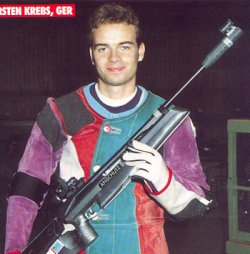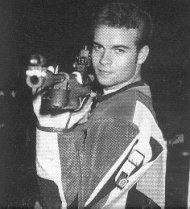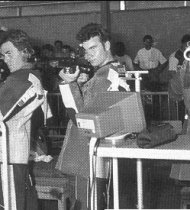INTERVIEW WITH TORSTEN KREBS
The winner of twelve German National Titles, Torsten Krebs has also been very successful internationally. He has held the German Air Rifle record at 598, and was the holder of the World Record at 597. We spoke to him in Munich in January 2001 and discovered a man who has found success through intelligently applying himself to his sport.
When did you start shooting?
I started shooting in 1985 at the age of 12.
Where are you from?
I’m from Schifferstadt, near the French border in the south west of Germany. We have some very good wrestlers, some Olympic champions from down there.
Did you start with air rifle.
Yes, because in Germany you are only allowed to start with an air rifle at that age. When I was 14 I started smallbore.
Have you always used the same brand of rifle?
No. In the beginning when I started shooting, the clubs they have beginners rifles, I used a Feinwerkbau Model 300S. After a few months I bought a used rifle, it was a Diana 75. But this was the time when the Feinwerkbau 600 was coming on the market and after maybe six months my dad bought me a 600. There were some limits with the other rifles I started shooting with – when I got the new rifle I jumped over that limit and I got better and better.
Do you take much time to test ammo?
Yes, I started batch testing pellets the first time I went to the German Championships. When I took my 600 to be serviced, to a gunsmith near my home town, he asked me if I had tested pellets. I told him no, I just bought them and shot them. He made me aware of the difference and I was very surprised that it could be better.
When did you start shooting the Anschutz?
I started shooting the Anschutz in 1993. It was a 2002 pneumatic.
What do you shoot in smallbore?
Also Anschutz. From the beginning on.
Who is your coach?
Erwin Haude. He is also from Schifferstadt.
What is your favorite training routine?
In the beginning I shot a lot of plain white targets, to learn trigger control, to learn to concentrate on the trigger and not to concentrate on the target. As I shot better and better groups I started to train, to practice the rhythm. The rhythm I think is very important. And then to go on to sighting shots, and competition shots. The transition from sighting shots to competition, when you push the button to start the match, sometimes the transition is very difficult in the mind, so to find a good rhythm is so important.
So you have a shot sequence that relies on a rhythm of motion?
Yes. When I have had a break of two weeks sometimes, when I start after this break, I shoot some on blank targets just to regain my rhythm. This is just to find the right feeling – for example how should be the feeling in the right hand, in the shoulder, in the left arm, how the muscles should be feeling.
How do you prepare for a big match?
If I am having some problems, when I am doing the same faults, if there are more shots on the right side (for example), I don’t know why, then I get on the SCATT system to see what is going on, what is the reason for that.
 How do you handle the mental game during a match, what do you think of?
How do you handle the mental game during a match, what do you think of?
Sometimes this is very difficult. I think you have to find your own way, how to handle this. You have to find a plan, how you handle different situations because when you’re shooting well sometimes it’s very hard to cool down, especially for beginner shooters. If you shoot nine tens, then the last can be very difficult. But the mental side can be very very difficult. So in my training at home I shoot ten shots and say this must be a hundred, so that I learn to handle this high result, and not worry about it. In a big competition you have to learn to think just about the technique. It may be on one part of my technique, on my trigger or the position of the left arm , and I concentrate on this to put away the bad thoughts.
That is a very good tactic, to concentrate on technique to stay away from harmful thoughts.
Yes. But sometimes it breaks – sometimes it doesn’t work. I think there are many influences and if you have the mental strength you will do it. But you should make your plan, what to do, in these situations.
Do you dry fire very much?
Sometimes. Now, during the winter months, with the open smallbore ranges closed because it’s too cold.
Do you find it beneficial?
Of course it is good training because you practice your conditions for prone or for kneeling and you hold your special feeling, but only the right feeling, how it feels to do a real shot.
You put a lot of importance on the muscle memory and how everything feels?
Yes, there is a lot to think about in this dry firing, so it isn’t so boring. Not just aiming on the target and doing the same thing, it is very good.
What advice would you give to a newer shooter or a junior just starting out?
I think I learned a lot from watching the other shooters. Especially the better shooters. Because when you walk around the shooting range you see a lot of different positions, so you have to ask yourself, “Why are they doing this? Why is their hand like this, in my situation would it be good or would it be bad for me in my position?” Also considering if it’s a taller or smaller shooter. And then you have to try this, if it works or not, and then you have to find your own shooting style. I think this is a good way to push your results, and your attitude as well, to think about what you are doing.
Do you change your front sight elements for different light conditions?
In smallbore it’s necessary because in air rifle the conditions are always the same. It’s important that you can change the size – sometimes when you come onto the range it’s very bright and I put my front sight a little bit smaller. I also use filters to get the best contrast.
These are different color filters?
Yes. Mostly gray or blue, they are the colors I prefer.
What size front ring do you use for air rifle?
I use a 4.5mm, it’s very big. I have some problems with my eyes. The last few years I shot between 4.1 and 4.3, but I think 4.5 is a little bit too big. I think for a young shooter the best is between 4.0 and 4.3, this is the best choice I feel.
You said something interesting before, about squeezing the trigger on a white card. Is it best to train it without a bull? Does that mean your trigger release is not conscious?
No, I think when I pull the trigger, it is conscious. It is not a surprise. I pull the trigger when I recognize that the sight picture is the best. I use a direct trigger of 40 grams. When you use an air pistol with 500 grams you can’t use that technique.
Thanks for your time, Torsten, and all the best for the future.